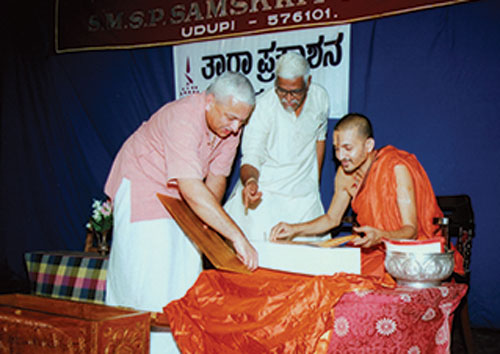Ancient Hindu book returns home
RIT scientists digitally restore weathered text
Submitted by P.R. Mukund
P.R. Mukund, the Gleason Professor of Electrical Engineering at RIT, left, presents a digitally restored copy of a sacred Hindu manuscript to his spiritual teacher Shri Bannanje Govindacharya, a Vedic scholar, center, and Shri Vidyadheesha Tirtha Swamiji, head of the Palimath math, in a ceremony in November in India. Roger Easton, professor of imaging science in RIT’s Chester F. Carlson Center for Imaging Science, Keith Knox, an imaging senior scientist at Boeing LTS, and alumnus Ajay Pasupuleti worked on the project.
Professor P.R. Mukund and alumnus Ajay Pasupuleti traveled to India in November with precious cargo: two bound copies of the digitally restored Sarvamoola Grantha, a 700-year-old sacred Hindu text inscribed on palm leaves. Mukund, the Gleason Professor of Electrical Engineering, presented the books in hand-carved teak boxes to his spiritual teacher and to the head of the Udupi monastery in an emotional public ceremony covered by The Times of India.
The books were printed at RIT with the help of John Eldridge, digital printing technologist, and his colleagues in the School of Print Media in the College of Imaging Arts and Sciences. “They went out of their way to help,” Mukund says. This phase of the project culminates months of work by the imaging team led by Mukund and Roger Easton, professor of imaging science, Keith Knox, an imaging senior scientist at Boeing LTS, and Pasupuleti, then a microsystems engineering doctoral candidate. Their goal was to digitize the decaying manuscript that contains commentaries on scriptures and analysis of holy texts attributed to philosopher-saint Shri Madhvacharya and to provide the monastery in Udupi, where it is housed, with a bound copy. The next phase of the project will be to etch the manuscript on silicon wafers, a clever use of a robust material as an archival medium.
News of RIT’s efforts to digitally restore the Sarvamoola Grantha has led serendipitously to two developments. The first opportunity came from Charles White, professor emeritus at American University, who had traveled extensively throughout India in the 1980s on behalf of the Smithsonian Institute and microfilmed more than 1,000 Hindu manuscripts, including palm leaves and printed works. Impressed by the Sarvamoola Grantha project, White offered Mukund his own microfilm collection to digitally restore. The American University gifted Mukund a copy of White’s 76 reels of microfilm containing more than 20,000 pages of Vaishnava literature. The collection contains Hindu sacred literature dating from 100 to 1000 years ago, including hymns and prayers, as well as extensive commentaries on the Sarvamoola Grantha by various scholars. Mukund is stunned by the overture. “It would be as if all the Catholic literature was handed to someone,” he says. “It’s that big.” The collection is in poor condition due to the quality of the original works and aging microfilm.
The imaging team will scan and digitalize each reel, then process and enhance the images. The digital documents will be printed on archival paper and bound into books. Mukund anticipates the microfilms will yield approximately 1,000 books that scholars lack access to today. The larger aspect of the project will include creating a detailed catalog of the hard copy and digital documents according to schools of thought. The digital documents will remain at RIT. The hard copy documents will be housed at the Sri Venkateswara Central Library and Research Centre in the town of Tirupati, an ancient pilgrimage destination in southern India. A senior government official who had learned of White’s gift to Mukund offered to dedicate a wing of the library as a repository for the collection. This second unexpected development has pushed the project forward and given it a tight deadline coinciding with the inauguration of the dedicated library space in August. To complete the project, Mukund and Easton will establish a lab at RIT and hire two full-time post-doctoral fellows. The realization of both projects—transferring the Sarvamoola Grantha to silicon wafers and digitally preserving the vast collection of Vaishnava literature—depends on adequate funding.
Mukund is currently accepting donations for both efforts. Mukund, his students and Easton have personally donated more than $25,000 to the project and seek another $75,000 to cover expenses. Interested donors can contact Mukund at prmeee@rit.edu or at 475-2174.









